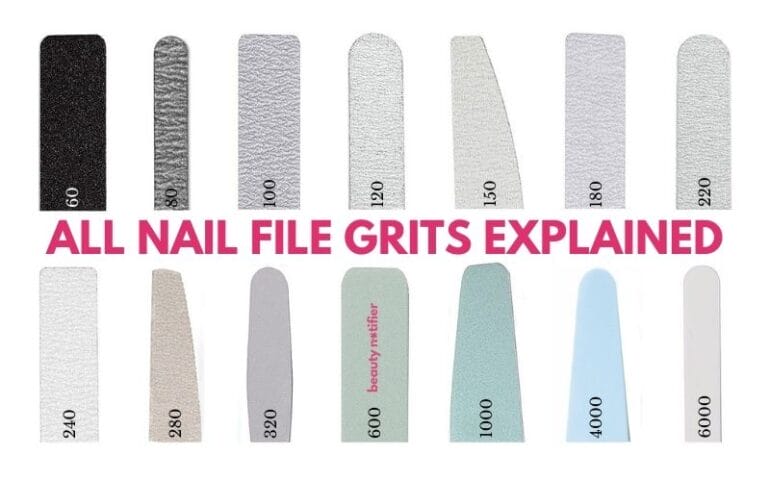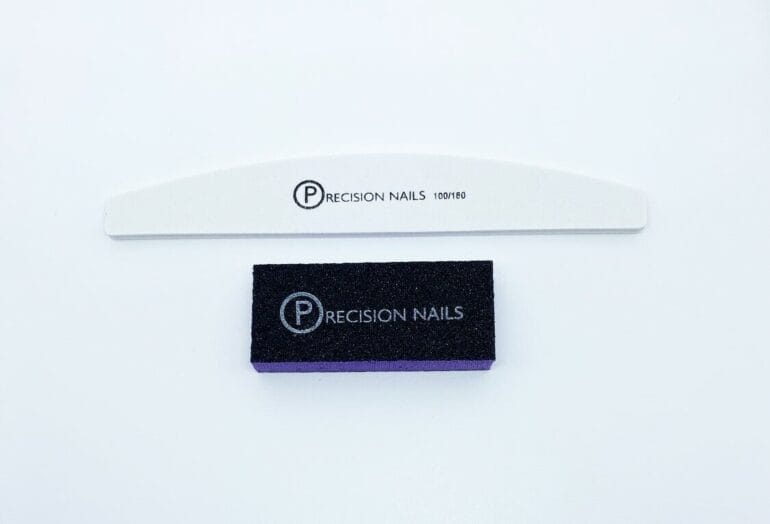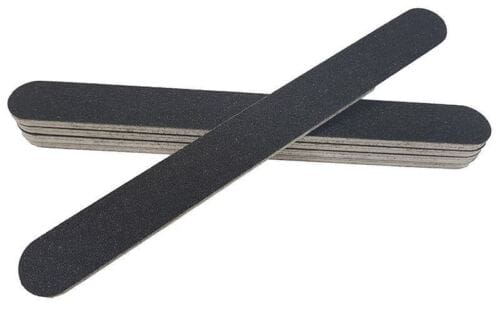Choosing the right grit nail file for acrylics is essential for achieving the perfect manicure.
A grit nail file refers to the roughness or coarseness of the file’s surface, which determines how much material it can remove from your nails.
When it comes to acrylic nails, a medium grit file, typically around 180 to 240 grit, is recommended.
This grit level is effective in shaping and smoothing the edges of acrylic nails without causing excessive damage or weakening the nails.
Remember, using the appropriate grit nail file will ensure a precise and professional-looking finish for your acrylic nails.

Understanding Grit Sizes: Decoding the Numbers on Nail Files for Acrylics
When it comes to achieving perfectly manicured acrylic nails, choosing the right nail file is crucial. Nail files come in various grit sizes, which may seem confusing if you’re unfamiliar with the terminology. In this section, we will decode the numbers on nail files for acrylics and help you understand grit sizes.
What is Grit Size?
Grit size refers to the coarseness or fineness of the abrasive particles on a nail file. The grit number indicates the number of particles per square inch on the file’s surface. In general, the higher the grit number, the finer the file’s texture.
Understanding the Grit Scale
There are different grit scales used in the nail industry, but the most common one is the American National Standards Institute (ANSI) scale. This scale ranges from 40 to 8000 grit, with each number representing a specific level of coarseness or fineness.
Here’s a breakdown of the ANSI grit scale and its corresponding coarseness:
| Grit Number | Coarseness |
|---|---|
| 40 – 60 | Extra Coarse |
| 80 – 120 | Coarse |
| 180 – 240 | Medium |
| 320 – 500 | Fine |
| 600 – 1000 | Extra Fine |
| 1200 – 8000 | Ultra Fine |
Choosing the Right Grit Size for Acrylic Nails
The ideal grit size for your acrylic nails depends on various factors, including the length and thickness of your nails, as well as your personal preference. Here’s a general guide to help you choose the right grit size:
- Extra Coarse (40 – 60 grit): Use this grit size to quickly shape and shorten long acrylic nails.
- Coarse (80 – 120 grit): Ideal for refining the shape of your nails and removing any rough edges.
- Medium (180 – 240 grit): Suitable for smoothing the surface of your nails and removing scratches.
- Fine (320 – 500 grit): Use this grit size to further refine the nail surface and prepare it for polishing.
- Extra Fine (600 – 1000 grit): Perfect for achieving a smooth and polished finish on acrylic nails.
- Ultra Fine (1200 – 8000 grit): This grit size is typically used for buffing and shining the nails.
It’s important to note that using a file with a higher grit number may take longer to achieve the desired result, but it will provide a smoother finish. On the other hand, lower grit numbers are more aggressive and may remove more material from the nails.
In summary, understanding grit sizes is essential when choosing a nail file for acrylic nails. The grit number indicates the coarseness or fineness of the file’s texture, with higher numbers representing finer grit. By selecting the right grit size, you can achieve the desired shape, smoothness, and finish for your acrylic nails. Remember to consider the length and thickness of your nails, as well as personal preference, when choosing the appropriate grit size.

Grit 101: Exploring the Different Grit Options for Acrylic Nail Files
When it comes to achieving the perfect acrylic nails, having the right tools is essential. One such tool that plays a crucial role in the nail enhancement process is the acrylic nail file. These files are designed to shape, smooth, and refine the acrylic nails, giving them a flawless finish. However, not all acrylic nail files are created equal. They come in a variety of grit options, each serving a specific purpose. In this section, we will explore the different grit options available for acrylic nail files and their ideal uses.
1. Coarse Grit (80-100)
The coarse grit acrylic nail files, ranging from 80 to 100, are incredibly abrasive. They are primarily used for quickly removing bulk acrylic material and reshaping the nails. Due to their aggressive nature, these files should be used with caution to prevent over-filing or damaging the natural nail bed.
Coarse grit files are ideal for nail technicians who need to create a new nail shape or significantly shorten the length of the nails. They are also suitable for removing stubborn gel or acrylic overlays.
2. Medium Grit (120-180)
The medium grit acrylic nail files, with a grit range of 120 to 180, have a less aggressive texture compared to coarse grit files. They are commonly used for refining and smoothing the nail surface after using a coarse file. These files help to eliminate any rough edges, creating a more polished look.
Medium grit nail files are perfect for reducing the thickness of acrylic nails without removing too much material. They can also be used to shape the sidewalls and remove any jagged edges.
3. Fine Grit (240-320)
The fine grit acrylic nail files, ranging from 240 to 320, have a smoother texture and provide a gentler filing experience. They are primarily used for buffing and refining the nail surface, eliminating any visible scratches or imperfections left behind by the coarser files.
Fine grit files are ideal for achieving a smooth and shiny finish on the nails. They are also suitable for blending the tips of acrylic nails with the natural nails, creating a seamless look.
4. Extra Fine Grit (400+)
The extra fine grit acrylic nail files, typically ranging from 400 and above, are the least abrasive of all the grit options. They are designed for the final touches and fine-tuning of the nails. These files help to smooth out any remaining ridges or imperfections, leaving the nails perfectly polished.
Extra fine grit files are perfect for achieving a high-gloss shine on the nails. They can also be used to refine the shape of the nails and remove any last traces of roughness.
Choosing the Right Grit
Choosing the right grit for your acrylic nail file depends on the desired outcome and the stage of the nail enhancement process. If you need to remove a significant amount of acrylic material or reshape the nails, a coarse grit file would be ideal. For refining the shape and smoothing out rough edges, a medium grit file is recommended. To achieve a polished and flawless finish, a fine or extra fine grit file should be used.
Remember, it is essential to handle the acrylic nail files with care and gradually work your way up to a finer grit to avoid damaging the nails. Regularly cleaning and sanitizing the files is also crucial to maintain their effectiveness and prevent the spread of bacteria.
In summary, the different grit options for acrylic nail files offer various levels of abrasiveness, each serving a specific purpose in the nail enhancement process. By understanding the characteristics of each grit, you can choose the right file to achieve the desired outcome and ensure perfect acrylic nails every time.

4. Nail File Grit Guide: Picking the Ideal Grit for Your Acrylic Nail Care
When it comes to caring for your acrylic nails, choosing the right nail file grit is essential. The grit of a nail file refers to the roughness or coarseness of the surface. Different grits are designed for specific tasks, and using the wrong grit can lead to damage or ineffective results. In this section, we will guide you through the different grit options available and help you select the ideal nail file grit for your acrylic nail care routine.
1. Understanding Nail File Grits
Nail files are categorized by grit numbers, which indicate the level of coarseness. The higher the grit number, the finer the file’s surface. Here are the common types of nail file grits:
– Fine Grit (240-320): Fine-grit nail files are ideal for finishing and smoothing the edges of natural or acrylic nails. They are gentle on the nails and create a polished, smooth surface.
– Medium Grit (100-180): Medium-grit nail files are versatile and suitable for shaping and shortening both natural and acrylic nails. They can effectively remove rough edges and shape the nails to your desired length.
– Coarse Grit (80-100): Coarse-grit nail files are designed for heavy-duty tasks, such as removing excess acrylic or gel overlays. They are more abrasive and should be used with caution to avoid over-filing or damaging the natural nails.
2. Choosing the Right Grit
Now that you are familiar with the different grits available, let’s discuss how to choose the right nail file grit for your acrylic nail care:
a) Nail Length: For longer nails, a coarser grit file may be necessary to remove excess length. Shorter nails can be maintained and shaped using a medium or fine grit file.
b) Nail Thickness: If your acrylic nails are thick, you may need a coarser grit file to effectively file down the thickness. Finer grits are suitable for thinner acrylic overlays.
c) Nail Condition: Consider the condition of your nails. If they are weak or damaged, opt for a finer grit file to prevent further damage. For stronger nails, a medium grit file can be used.
d) Purpose: Determine the purpose of filing. If you need to reshape or shorten your nails, a medium grit file will suffice. For removing overlays or bulk acrylic, a coarser grit file may be required.
3. Proper Technique for Acrylic Nail Care
Using the right nail file grit is essential, but proper technique is equally important for effective acrylic nail care. Follow these steps to care for your acrylic nails:
- Start by removing any nail polish or coatings from the nails.
- Use a gentle nail brush to clean the nails and remove any dirt or debris.
- Choose the appropriate grit file based on your nail length, thickness, and purpose.
- Gently file the edges of the nails in one direction, avoiding a back-and-forth sawing motion.
- If needed, shape the nails by filing from the outer edges towards the center.
- Be cautious not to file too aggressively or apply excessive pressure, as this can damage the natural nails.
- Once the desired shape and length are achieved, use a finer grit file to smooth and refine the nail surface.
- Finish by buffing the nails with a nail buffer to create a polished, shiny appearance.
- Moisturize your hands and nails to keep them hydrated and healthy.
Summary
In summary, choosing the right nail file grit is crucial for maintaining and caring for your acrylic nails. Consider the length, thickness, and condition of your nails when selecting a grit. Remember to file gently and in one direction to avoid damage, and always moisturize your nails after filing to keep them in optimal condition. By following these guidelines, you can ensure that your acrylic nails stay beautiful and well-maintained.
Achieving Flawless Results: Mastering the Art of Using the Right Grit Nail File for Acrylics
When it comes to achieving flawless results in your acrylic nail application, one of the key factors to consider is the type of nail file you use. The grit of a nail file plays a significant role in shaping and smoothing the acrylic surface, and using the right grit can make all the difference in the final outcome. In this section, we will explore the different grit options available and provide expert tips on how to choose and use the right nail file for your acrylics.
Understanding Nail File Grits
Nail files are categorized based on their grit, which refers to the coarseness or fineness of the abrasive surface. Grit is measured in numbers, with lower numbers indicating a coarser grit and higher numbers indicating a finer grit. The three most common grits used for acrylic nails are:
- 80-100 Grit: Coarse
- 180-240 Grit: Medium
- 320-400 Grit: Fine
Each grit serves a specific purpose in the acrylic nail application process, and understanding their differences is crucial to achieving the desired results.
Choosing the Right Grit
The choice of nail file grit depends on the stage of the acrylic application process. Here’s a breakdown of when to use each grit:
Coarse Grit (80-100)
Coarse grit nail files are ideal for shaping the initial length and thickness of acrylic nails. They are effective in quickly removing excess product and creating the desired shape. However, caution must be exercised while using coarse grit files to prevent over-filing, which can weaken the natural nail.
Medium Grit (180-240)
Medium grit files are commonly used for refining the shape and surface of acrylic nails. They help in removing any visible bumps or filing marks left by the coarse grit file. The medium grit allows for more precision without being too harsh on the natural nail.
Fine Grit (320-400)
Once the desired shape is achieved, a fine grit file is used for buffing and smoothing the surface of the acrylic nails. Fine grit files create a polished finish and eliminate any remaining imperfections. They are also suitable for natural nail maintenance and gentle reshaping.
Proper Technique for Using Nail Files
Using the correct technique when filing acrylic nails is as important as choosing the right grit. Here are some tips to achieve flawless results:
- Start by holding the nail file at a 45-degree angle to the nail surface.
- Gently file in one direction rather than back and forth to avoid unnecessary friction.
- Use light and even pressure to prevent damage to the natural nail.
- Take breaks during filing to assess the progress and avoid over-filing.
- Finish off with a buffing block or a fine grit file for a smooth and shiny surface.
Remember, practice makes perfect, and mastering the art of using the right grit nail file for acrylics requires patience and precision. With time and experience, you will develop a technique that yields flawless results.
In summary, achieving flawless results in acrylic nail application is achievable by using the right grit nail file. The choice of grit depends on the stage of the process, with coarse grit for shaping, medium grit for refining, and fine grit for buffing and smoothing. By following proper filing techniques and being mindful of the natural nails, you can achieve professional-looking acrylic nails at home or in the salon. So, next time you embark on your acrylic nail journey, remember to choose the right grit nail file for flawless results.
FAQs
What grit nail file is best for acrylics?
A 100-180 grit nail file is recommended for acrylics. The lower grit helps to file down the bulk of the acrylic material, while the higher grit smooths and finishes the nail surface.
Can I use a regular nail file on acrylic nails?
It is not recommended to use a regular nail file on acrylic nails. Regular nail files are typically less coarse and may not effectively file down acrylic material. It’s best to use a nail file specifically designed for acrylics to achieve the desired results.
How often should I replace my acrylic nail file?
It is recommended to replace your acrylic nail file every 3-6 months or sooner if it becomes dull or worn out. A dull file can cause damage to the nail surface and may not provide a smooth finish.
Conclusion
In conclusion, choosing the right grit nail file for acrylics is crucial for achieving a professional-looking result. The ideal grit level for acrylic nails is typically between 100-180, as it provides the perfect balance of effectiveness and gentleness. A coarse grit file (80-100) can quickly shape and remove bulk, while a finer grit (180 or higher) is ideal for refining the nail shape and minimizing damage. Remember to always use a light touch and gentle strokes when filing acrylics to avoid over-filing or causing damage to the natural nail. With the right grit nail file, you can achieve beautiful acrylic nails with ease.
